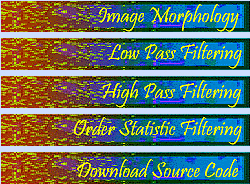|
Mathematical Morphology for image processing consists of applying
basic set operations to an image. Mathematical Morphology is
based upon Minkowski operators and DeMorgan's (complement modulo
2) laws. It should be noted that Minkowski operations and DeMorgans
Laws apply to binary valued sets (Black and White Images).
Minkowski operators consist of a type of addition and a type
of subtraction. Minkowski Addition, also known as Dilation, consists
of taking a set known as a structuring element and applying it
to each member in the source set. In the continuous case Minkowski
addition can be thought of as a way to grow the members of source
set by a method of psuedoconvolution. In image processing it
is rare to use the continuous case of Minkowski addition, instead
the discrete case is used. To implement discrete Minkowski addition,
on an image, the structuring element is applied to each pixel
in the source image. Applying the source image to each pixel
means that the origin of the structuring element is translated
to each pixel in the source image that has a value of one (remember
that this is for binary images). Then every pixel where either
the source image or the structuring element contain a "one"
the output image pixels are set to ones. This either operation
is the simple binary OR operation.
Minkowski Subtraction, also known as
Erosion, consists of taking the structuring element and sliding it
about the source image just as in Dilation. However instead of ORing
the source image with the structuring element the images are ANDed
for each translated/shifted movement of the structuring
element.
|





